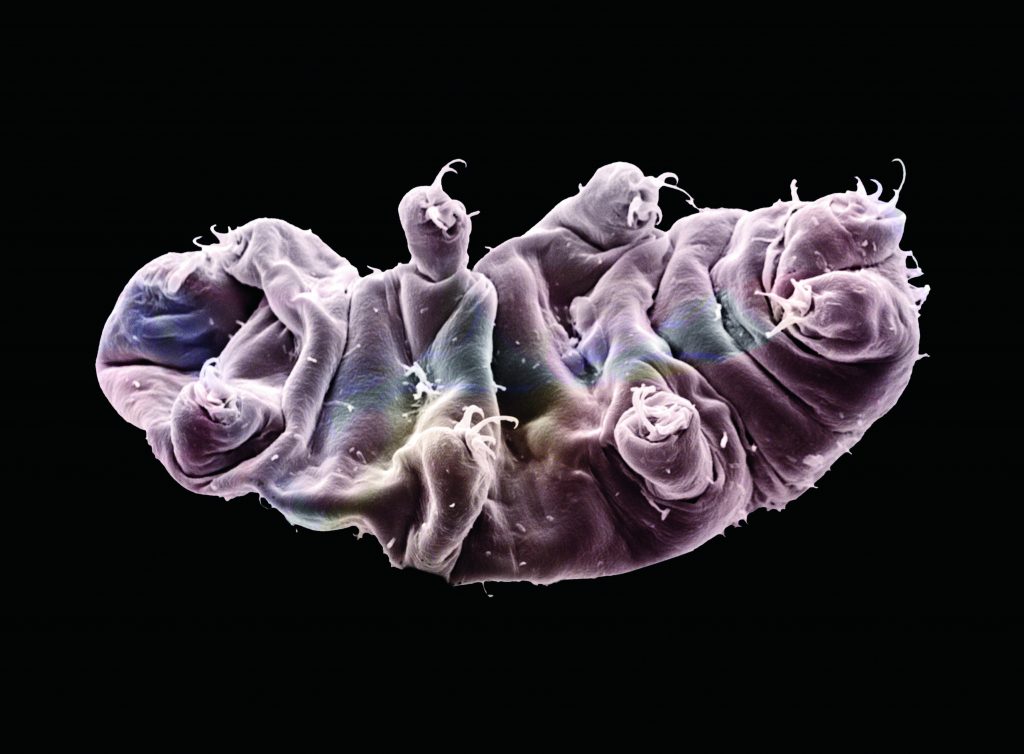
Tiny masters of inhospitable frontiers
By YD Bar-Ness, with Dr Wataru Abe
What creature has eight telescopic legs, can survive the harsh conditions of outer space, and looks like a small bear? Among the smallest animals on Earth, tardigrades are the most tenacious creatures that you have never heard of.
Found in a surprisingly wide range of environments on land and sea, more than 1,000 species of tardigrades, with new species being reported each year, have inspired scientists with their remarkable toolkit of abilities to survive unimaginably hostile conditions.
These invertebrate animals, about 0.05–1 millimetre in length, are small enough to stand on the dot at the end of this sentence, but they have been found in the deepest ocean waters, as much as 4,000 metres below, and at the highest mountain peaks, above 6,000 metres. On dry land, they are most often studied in moss and lichen, where they thrive in the complex structural environment. Mosses growing on buildings, What creature has eight telescopic legs, can survive the harsh conditions of outer space, and looks like a small bear? Among the smallest animals on Earth, tardigrades are the most tenacious creatures that you have never heard of.
Found in a surprisingly wide range of environments on land and sea, more than 1,000 species of tardigrades, with new species being reported each year, have inspired scientists with their remarkable toolkit of abilities to survive unimaginably hostile conditions.

These invertebrate animals, about 0.05–1 millimetre in length, are small enough to stand on the dot at the end of this sentence, but they have been found in the deepest ocean waters, as much as 4,000 metres below, and at the highest mountain peaks, above 6,000 metres. On dry land, they are most often studied in moss and lichen, where they thrive in the complex structural environment. Mosses growing on buildings, walls and pavements are one of their favourite habitats. Although a few species are known to be parasites of barnacles and sea cucumbers, almost all species are free-living.
Tardigrades are named from the Latin word for “slow walker” and their heavy build gives them an intriguing similarity to humans’ much closer relatives, the bears. Their eight pseudo-legs are sometimes tipped with claws and curiously, the rear pair of legs is rotated backwards. Tardigrades have rudimentary brains and nerve cords and some have armoured plates and telescopic legs.
The oldest records of animals resembling tardigrades have been found in Siberian fossils 500 million years old. They appear to have evolved from a freshwater organism and then colonised dry land and the saltwater ocean. Recent genetic testing has confirmed that they are a sister group to the arthropods (insects, spiders, crustaceans). To function, they require a thin film of fresh water in their environment, but tardigrades have a phenomenal capacity to enter a state of near-invulnerable stasis that was perhaps evolved to survive dry periods in terrestrial environments.
Scientists have exposed these animals to extreme conditions in experimental settings. Tardigrades have withstood temperatures near absolute zero (–273°C) and above 150°C (well beyond the boiling point of water). They can survive almost complete dehydration – one specimen was rehydrated after a century of desiccation in a dried moss sample and was still alive! They have survived pressurisation six times as intense as that in the deepest ocean trenches and have been exposed to unnaturally high levels of salt concentration.

Most surprisingly, tardigrades can even survive in space. In a 2007 European Space Agency mission, tardigrades were exposed to the cosmic rays, inhospitable chill, and minute pressure of the vacuum of space. Under such conditions, tardigrades enter a dormant state called cryptobiosis, withdrawing their legs, shrinking to a form not unlike a wine barrel, and ceasing metabolism. After 10 days of exposure, they reawakened from this cryptobiotic state, having survived conditions that would kill almost any other complex organism.
In their dormant state, tardigrades can be dispersed by wind and water to surprising places. Like seeds and pollen in the wind, they can travel our planet on gusts of air and find new environments. Remarkably, tardigrades can even reproduce by parthenogenesis – they do not need a sexual partner to create viable offspring. They are, perhaps, the ultimate explorers of inhospitable frontiers.
For more stunning stories and photographs from this issue, check out Asian Geographic Issue 110.










